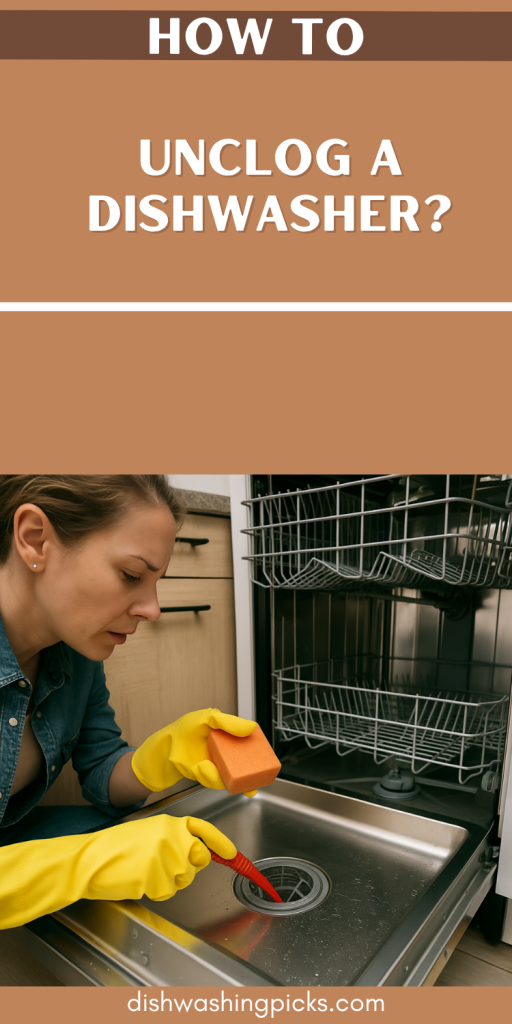
(Because Yep, It Can Totally Get Clogged…)
Let’s be honest—
A dishwasher is one of those appliances you don’t really think about… until it starts acting up. One day it’s cleaning your plates like a champ, and the next you open it up to find a puddle of suspicious water and your dishes still covered in last night’s spaghetti sauce.
So, what gives?
If your dishwasher’s draining slower than you getting out of bed on a Monday morning, chances are—it’s clogged.
But don’t panic.
We’re not calling the plumber just yet. You might be able to fix this mess in your PJs, with a sponge in one hand and a little know-how in the other.
First Things First: Is It Really Clogged?
Before you go full DIY hero mode, let’s make sure this is actually a clog situation and not something else weird.
Ask yourself:
- Is water pooling at the bottom after a cycle?
- Are your dishes still wet and grimy?
- Does it smell like something died in there?
If you’re mentally checking boxes—yup, that’s likely a clog.
Time to roll up those sleeves.
Step 1: Check the Basics (aka “Did You Try Turning It Off and On?”)
Okay, I know this sounds obvious, but hear me out:
Sometimes the issue isn’t a clog.
It’s a tripped breaker, a paused cycle, or someone accidentally hit the wrong setting.
So, do a quick reset:
- Turn off the dishwasher.
- Unplug it (or flip the breaker).
- Wait like 60 seconds.
- Power it back on and try a cycle.
Still not draining? Yep, it’s time for real action.
Step 2: Clean Out the Filter (It’s Probably Gross)
You ever pull out the dishwasher filter and find mystery gunk you wish you hadn’t seen?
Well, now’s your moment.
Here’s what to do:
- Pull out the bottom rack.
- Locate the filter (usually a round, twist-out thing at the base).
- Take it out and brace yourself.
- Rinse under hot water and scrub gently with a brush or sponge.
- If you’re feeling brave, soak it in vinegar for bonus points.
Gunked-up filters are major clog culprits. Sometimes this step alone solves the whole issue.
Step 3: Check the Drain Hose (Spoiler: This One’s Sneaky)
If cleaning the filter didn’t work, the drain hose might be the troublemaker.
What is it?
Basically the tube that sends dirty water out from the dishwasher and into your sink drain or garbage disposal.
Here’s the plan:
- Pull out the dishwasher (yeah, this part’s annoying).
- Look for a flexible tube leading to your sink’s plumbing.
- Detach it (have a towel or bucket ready—ew).
- Run some water through it or use a coat hanger (gently!) to dislodge any gunk.
Clogged hose = no draining. Simple as that.
Step 4: Clean the Garbage Disposal (If You Have One)
Okay, fun fact:
If your dishwasher drains into the garbage disposal, a clog there can back things up like traffic at rush hour.
Try this:
- Run the disposal with water flowing.
- Check for stuck food bits.
- Look underneath for a reset button (yes, it’s a thing).
- Still nothing? Time to break out the Allen wrench and spin the little rotor.
Sometimes, this is the hidden villain behind your dishwasher drama.
Step 5: Vinegar + Baking Soda = Magic Combo
Let’s get science-y (but in a fun way).
This is your natural, no-chemicals trick for clearing mild clogs.
Here’s the mix:
- Pour 1 cup of baking soda into the bottom of the empty dishwasher.
- Add 1 cup of white vinegar right after.
- Let it sit and fizz like a middle-school volcano project.
- After 15–30 minutes, run a hot water cycle.
Boom—this combo can break up grease, soap scum, and whatever else is living in your drain line rent-free.
Step 6: When to Call in the Big Guns
Okay, so you’ve tried everything. Filters are sparkling. Hose is cleared. You even played mad scientist with vinegar.
And still—your dishwasher’s acting like it’s on strike.
If water’s still not draining or you hear weird noises, it could be a problem with the:
- Drain pump
- Motor
- Internal blockage
This is where it’s totally okay to call a professional. No shame. You did your part.
Final Thoughts: Don’t Let the Gunk Win
So there you have it.
Unclogging a dishwasher doesn’t require a degree in engineering—or a $200 service call (at least not right away).
A little elbow grease, a pinch of patience, and a sprinkle of baking soda might just do the trick.
Now go check your dishwasher filter.
I dare you.
And if you found this helpful?
Maybe give your other appliances a little love too. They’re working hard.
Want more real-life, no-fluff cleaning guides like this?
You know where to find me. Let’s unclog the world, one weird appliance problem at a time. 💪
